So you want to add a tree to your garden, but you’re working with a small garden space and aren’t sure what will fit? Well, you’ve come to the right place!
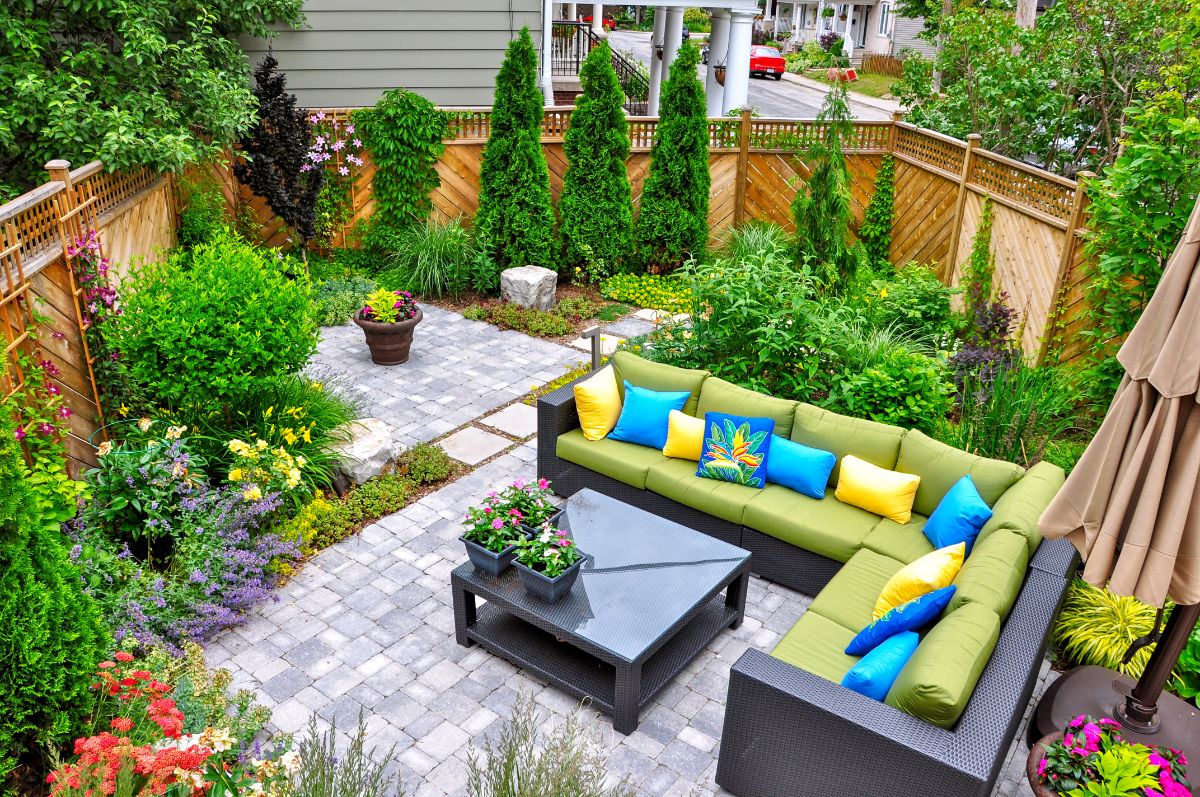
This article will cover the best trees for small gardens, as well as how to plant and grow them.
Jump to:
- 20 best trees for small gardens
- 1. Japanese maple
- 2. Ornamental cherry
- 3. Dogwood
- 4. Magnolia
- 5. Figs
- 6. Smoke tree
- 7. Crab apple
- 8. Dwarf Serbian spruce
- 9. Tricolor beech
- 10. Hawthorn
- 11. Chaste tree
- 12. Amelanchier
- 13. Espalier apple trees
- 14. Weeping larch
- 15. Redbud
- 16. Rowan
- 17. Purple fountain weeping beech
- 18. Loquat
- 19. Dwarf Olive tree
- 20. Dwarf Weeping Colorado spruce
- Benefits of adding trees to your small garden
- When is the best time to plant trees?
- How to plant your ornamental tree
- Conclusion
20 best trees for small gardens
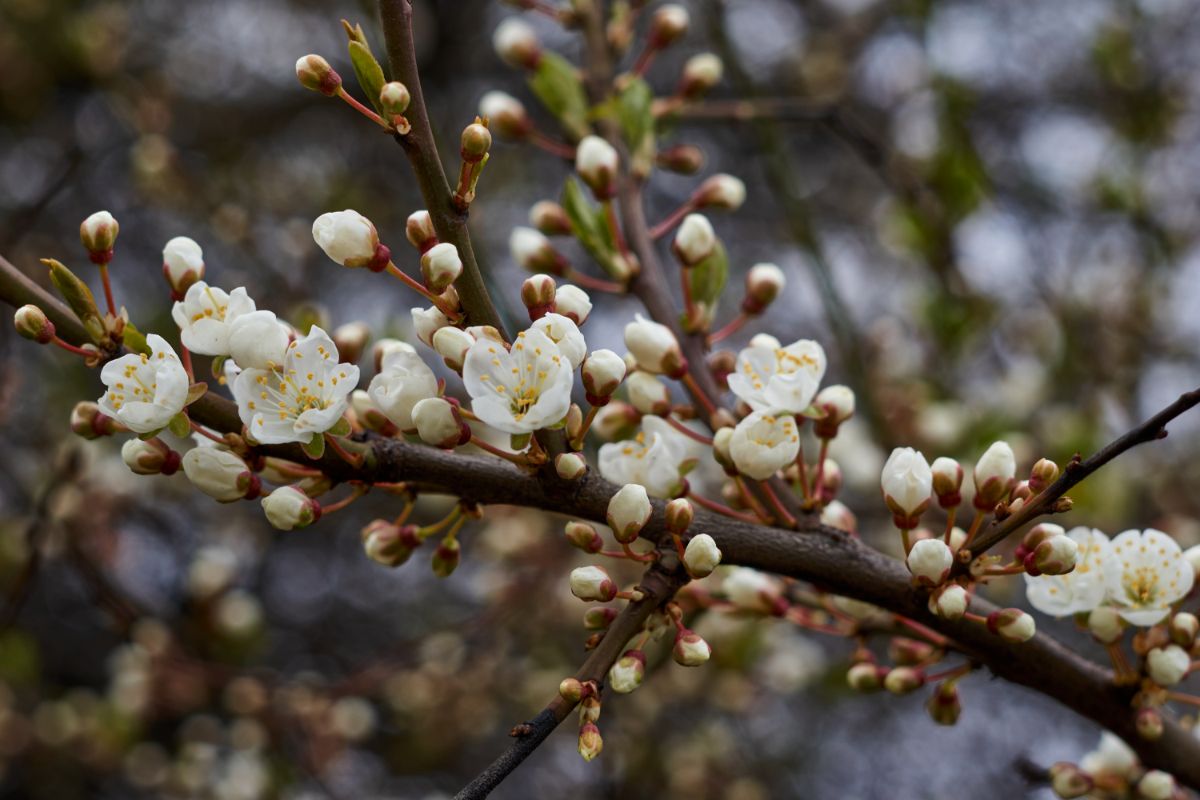
If you have a small backyard or even just a patio, you may not think you can squeeze any trees in. But think again! There are actually lots of ornamental specimen trees that work very well in small gardens, providing you with just the right amount of color, shade and form.
When choosing the right tree for your limited space, you’ll want to look for small or even dwarf varieties that will stay petite and not overwhelm your garden. Opt for trees that are neither too tall nor too bushy. For more pizzazz, varieties with a little something different – like colorful leaves or lots of flowers – are a good choice too.
Below we’ve selected our top 20 favorite trees for small backyards. Many of these trees come in different varieties, so it’s important to know what you’re buying and choose dwarf (rather than standard) sized trees if you have a small space.
Our selections include trees known for their vibrant leaves and hardy nature, and we’ve also selected some unique specimens with intriguingly architectural forms, edible fruits and other delights. There are even some pollinator favorites included here too if you’re looking for trees to plant for birds and other pollinators.
1. Japanese maple
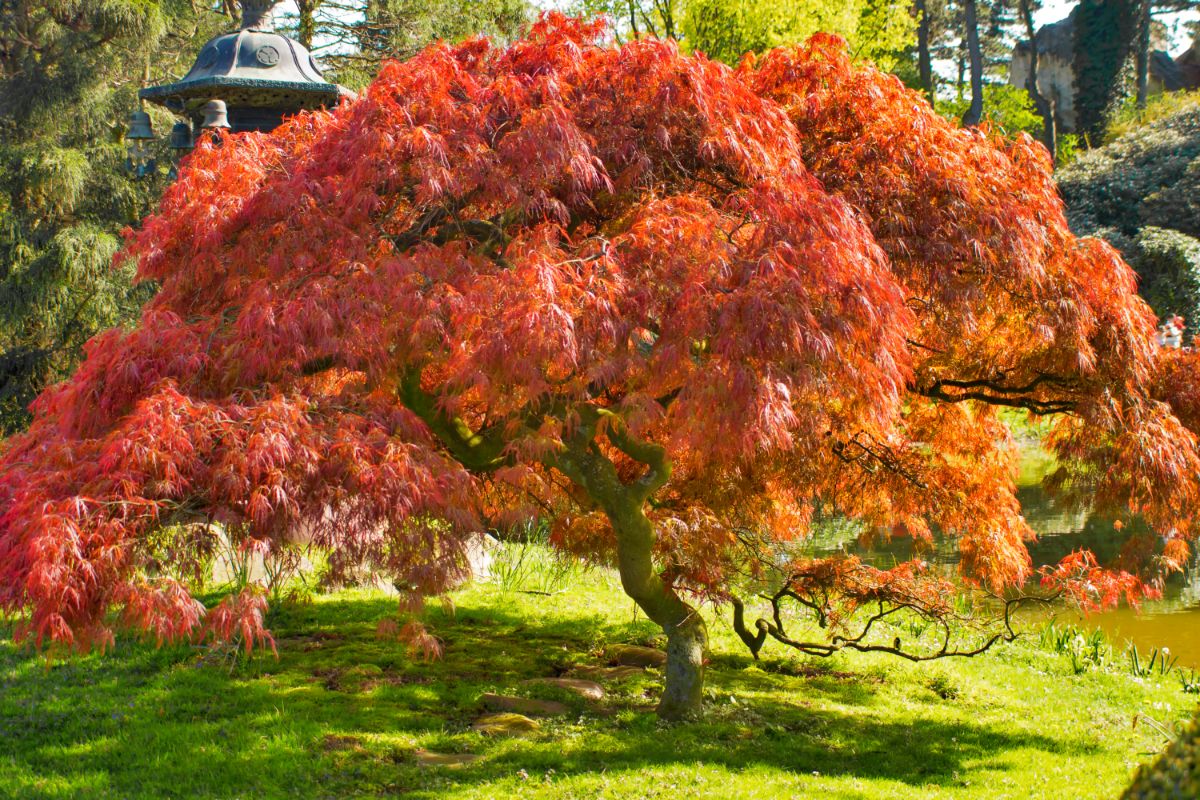
| Tree name: | Japanese maple |
| Growing zone: | Zones 5 to 8 |
| Size: | 3 to 8’ high (dwarf varieties); 15 to 25’ high (standard varieties) |
| Light requirements: | Full to part shade |
| Important features: | Colorful foliage |
It’s impossible to have a list of great ornamental trees without including Japanese maples. These beautiful ornamentals are famous for their jagged leaves that come in lots of colors; however, varieties with deep red leaves are some of the most popular. Retaining their color from spring through summer, leaves become even more vivid in fall.
With gently arching branches, these sculptural trees look just right nestled above a garden bench or when used to create a bit of shade over flower beds. Just keep in mind that Japanese maples do prefer shadier spots, as full sun can cause leaf burn.
2. Ornamental cherry
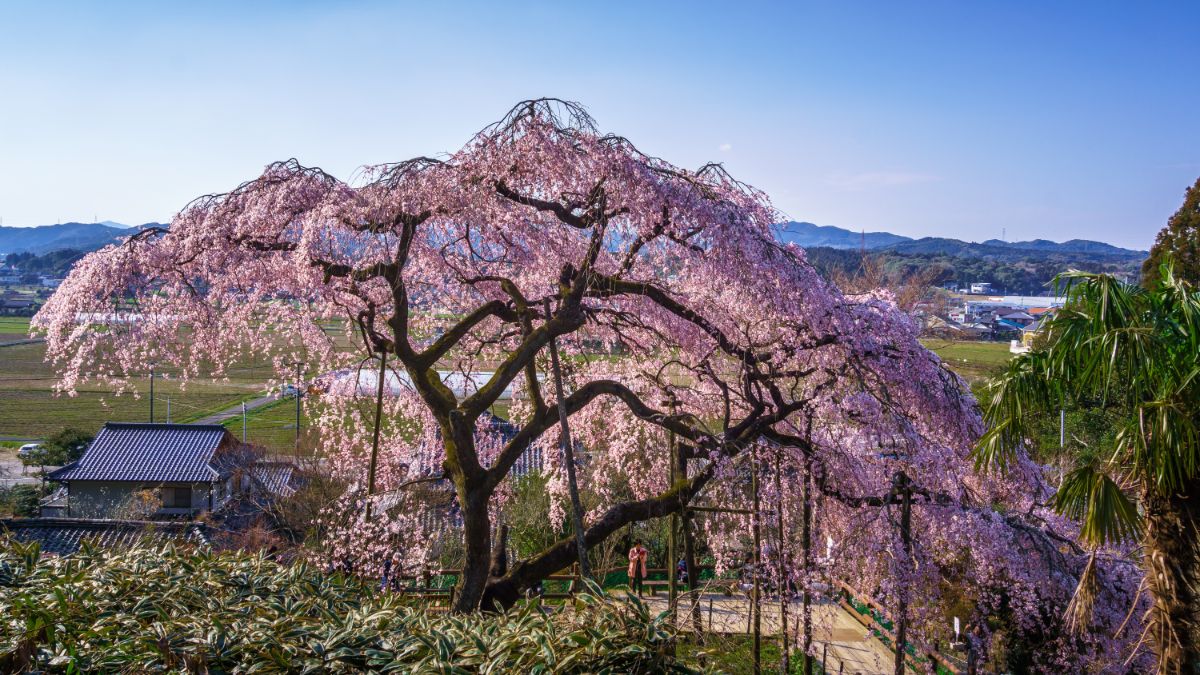
| Tree name: | Ornamental cherry |
| Growing zone: | Zones 5 to 8 |
| Size: | 6 to 10’ high (dwarf varieties); 20 to 30’ high (standard varieties) |
| Light requirements: | Full sun |
| Important features: | Produces flowers; excellent food source for early pollinators |
Cherry trees come in different sizes, but for smaller spaces, look for dwarf varieties like the dwarf weeping cherry. These gorgeous ornamentals bloom loads of cheery pink and white flowers in springtime that are a welcome sight after winter’s chill. Pollinators love them too!
After blooms fade, cherries can be pruned into trim shapes or allowed to grow naturally. Easy to keep, just provide these trees with plenty of sun and moist, well-draining soil and this showstopping specimen tree will be the star of your yard.
3. Dogwood
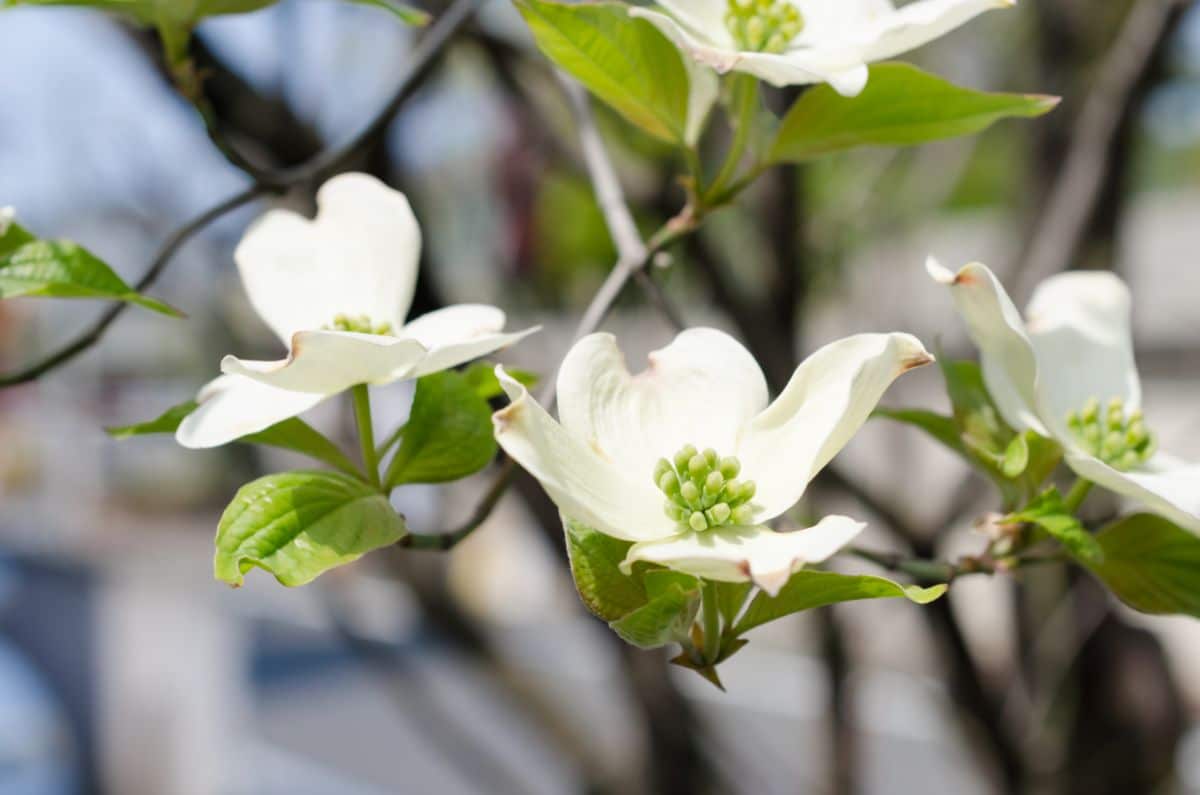
| Tree name: | Dogwood |
| Growing zone: | Zones 3 to 8 |
| Size: | 10 to 40’ high (depending on the variety) |
| Light requirements: | Full sun |
| Important features: | Produces flowers; fruit attracts birds |
Preferring moist well-draining soil, dogwoods can adapt to full sun or part shade, so they will work well in lots of different outdoors spaces. However, as some dogwoods can grow quite large (25’ high or larger), if your space is limited, be sure to select dwarf varieties like “Angyo Dwarf” if you can find it.
Blooming their trademark 4 petal flowers in June, most dogwood flowers are white, but pink and yellow varieties are available too. As flowers mature, they’ll develop into small, red fruit that look a bit like cherries. While these fruit aren’t edible for humans, they are a great food source for birds.
In autumn, your dogwood tree will keep impressing with colorful foliage too. And, with lots of new hybrids on the market, there are plenty of disease-resistant cultivars to choose from.
4. Magnolia

| Tree name: | Magnolia |
| Growing zone: | Zones 4 to 10 (depending on the variety) |
| Size: | 8 to 70’ high (depending on the variety) |
| Light requirements: | Full sun to part shade |
| Important features: | Produces flowers; fruit attracts birds |
There are many different types of magnolia trees available today – some are hardy for cooler regions and some are compact, dwarf varieties for small yards. Colorful, tulip-shaped flowers appear in spring and are often white, yellow or pink, but they come in other colors too.
Preferring moist soil, newly planted magnolias should be watered well and protected from late frosts, which can spoil flowers, turning them brown. A tasty treat for garden visitors, consider adding tree guards to your magnolias to protect them from deer, rabbits and other nibblers.
5. Figs
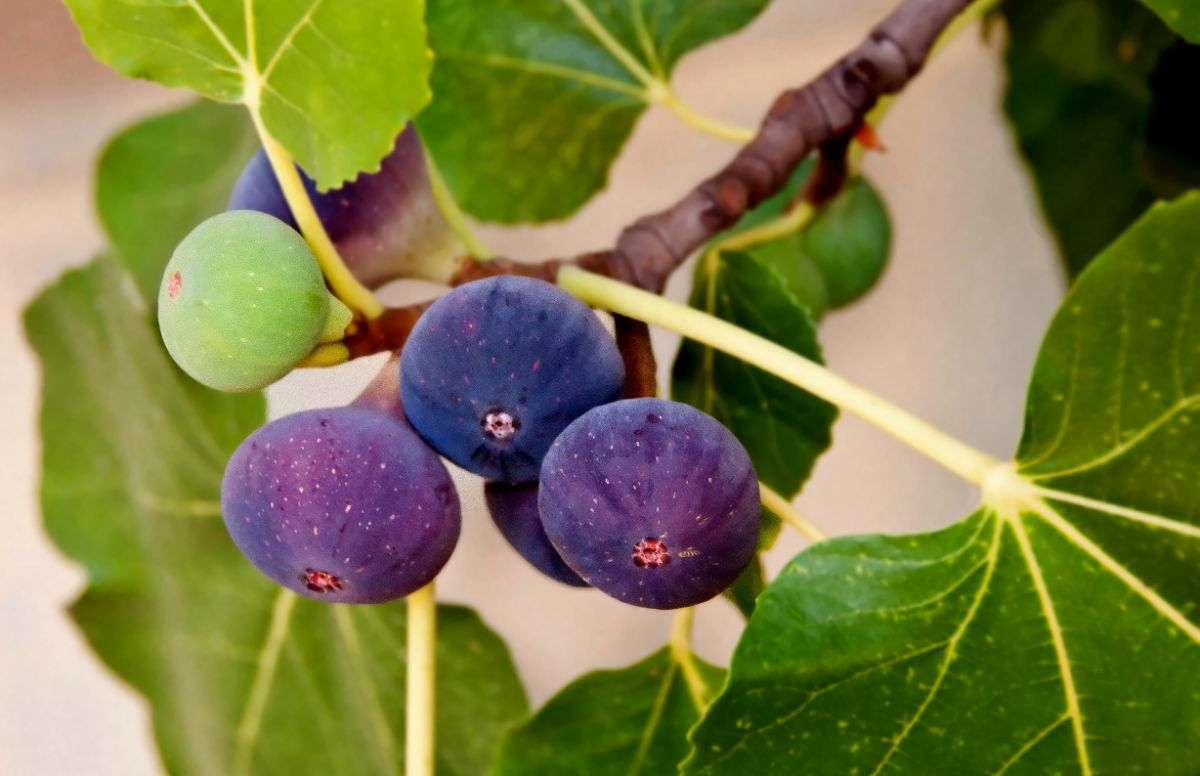
| Tree name: | Figs |
| Growing zone: | Zones 5 to 10 (depending on the variety) |
| Size: | 4 to 30’ high (depending on the variety) |
| Light requirements: | Full sun |
| Important features: | Edible fruit; container garden-friendly |
If you have a sweet tooth, why not grow some delicious figs in your backyard? That’s right, you can scratch “figs” off your grocery list, because they are actually quite easy to grow in backyards… even small ones!
Figs grow in warmer climates, so they may not be practical if you live in a cool area. However, certain fig varieties, like ‘Little Miss Figgy’ or ‘Celeste,’ stay small (reaching 3 to 4’ high) and are perfect for containers. Just bring them indoors when temperatures begin to drop.
For cooler areas, ‘Chicago Hardy’ can grow in regions as cool as zone 5, while ‘Brown Turkey’ is another tasty option, but it will grow a bit bigger (up to 20’ high).
6. Smoke tree
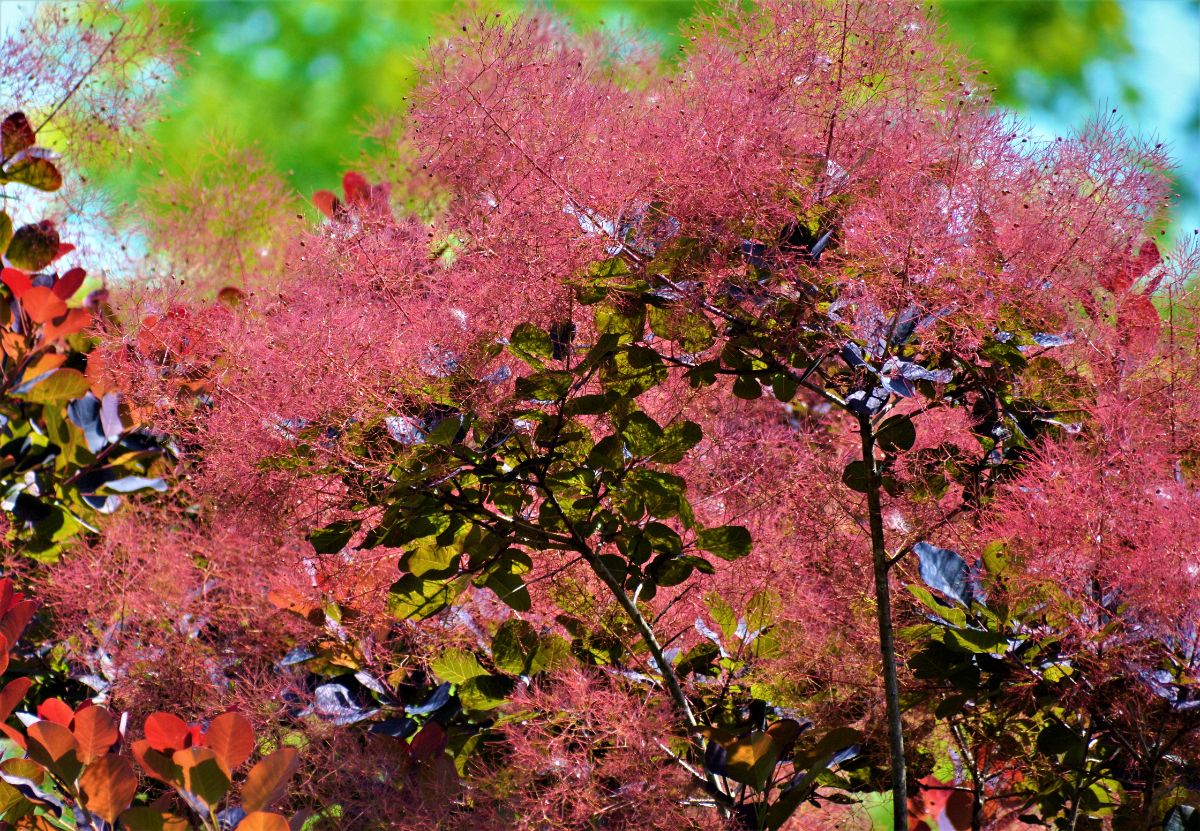
| Tree name: | Smoke tree |
| Growing zone: | Zones 5 to 8 |
| Size: | 10 to 15’ high |
| Light requirements: | Full sun |
| Important features: | Produces flowers; colorful foliage |
Growing up to 15’ tall, smoke trees are small space friendly, but they pack a punch. These intriguing trees bloom clusters of pink-toned flowers from June to September, which are highly coveted for their unique smoke-like look.
Reddish-toned, rounded leaves contrast nicely against those frothy flowers, and leaves are even more pleasing when they turn a vibrant orange in autumn. When planted in gardens, smoke trees are certain to elevate any design while adding an airy quality to your landscape.
7. Crab apple
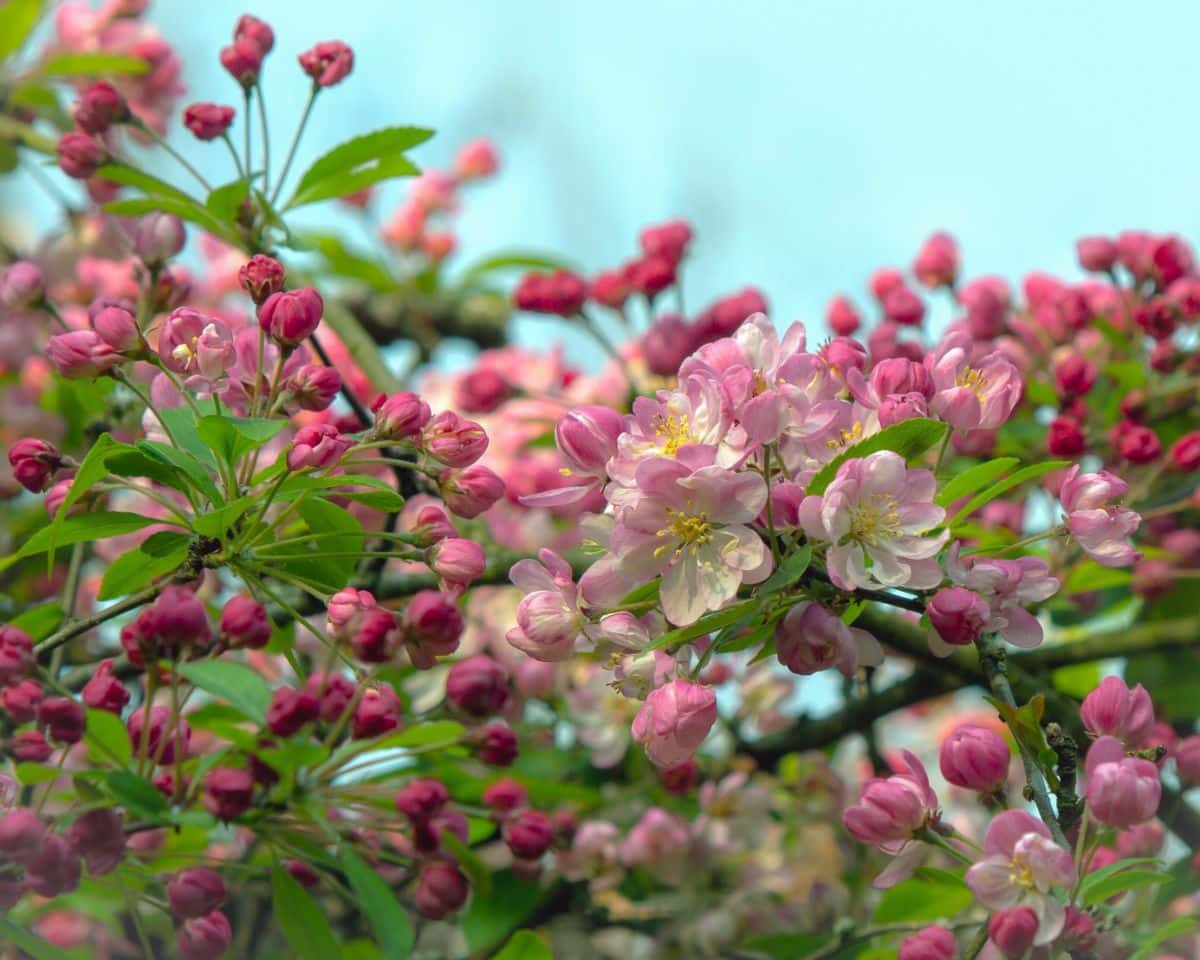
| Tree name: | Crab apple |
| Growing zone: | Zones 3 to 8 |
| Size: | 15 to 25’ high |
| Light requirements: | Full sun |
| Important features: | Produces flowers; edible fruit |
Perennial favorites, crab apples are a joy to behold when they bloom vivid clusters of bright pink flowers in springtime. By autumn, those flowers mature into small, brightly colored fruits which, though tart, are tasty when baked into pies or steeped into sweet jams and jellies.
Crab apples can come in different sizes, so be sure you know what you’re planting so you don’t end up accidentally choosing a large variety. Instead, opt for smaller crab apple trees, like ‘Wisley Crab’ and ‘Butterball,’ which grow to about 13’ in height.
While crab apples look great on their own, if you have the space for it, a row of flowering crab apple trees is just divine in springtime!
8. Dwarf Serbian spruce

| Tree name: | Dwarf Serbian spruce |
| Growing zone: | Zones 4 to 7 |
| Size: | 3 to 5’ high |
| Light requirements: | Full sun to part shade |
| Important features: | Pollinator shelter; year-round privacy |
Sought out for its densely growing branches, dwarf Serbian spruces are wonderful choices for pollinator gardens as they provide lots of shelter for birds. They also make great foundation plants for ornamental beds, where their short growth habit (maxing out at 3 to 5’ high) won’t overwhelm shorter plants.
Slow-growing and hardy to -30°F, these slow-growing trees maintain a compact pyramidal shape with no pruning needed. Siberian spruce trees are recognized by their abundance of bright green needles with white stripes on their undersides.
9. Tricolor beech
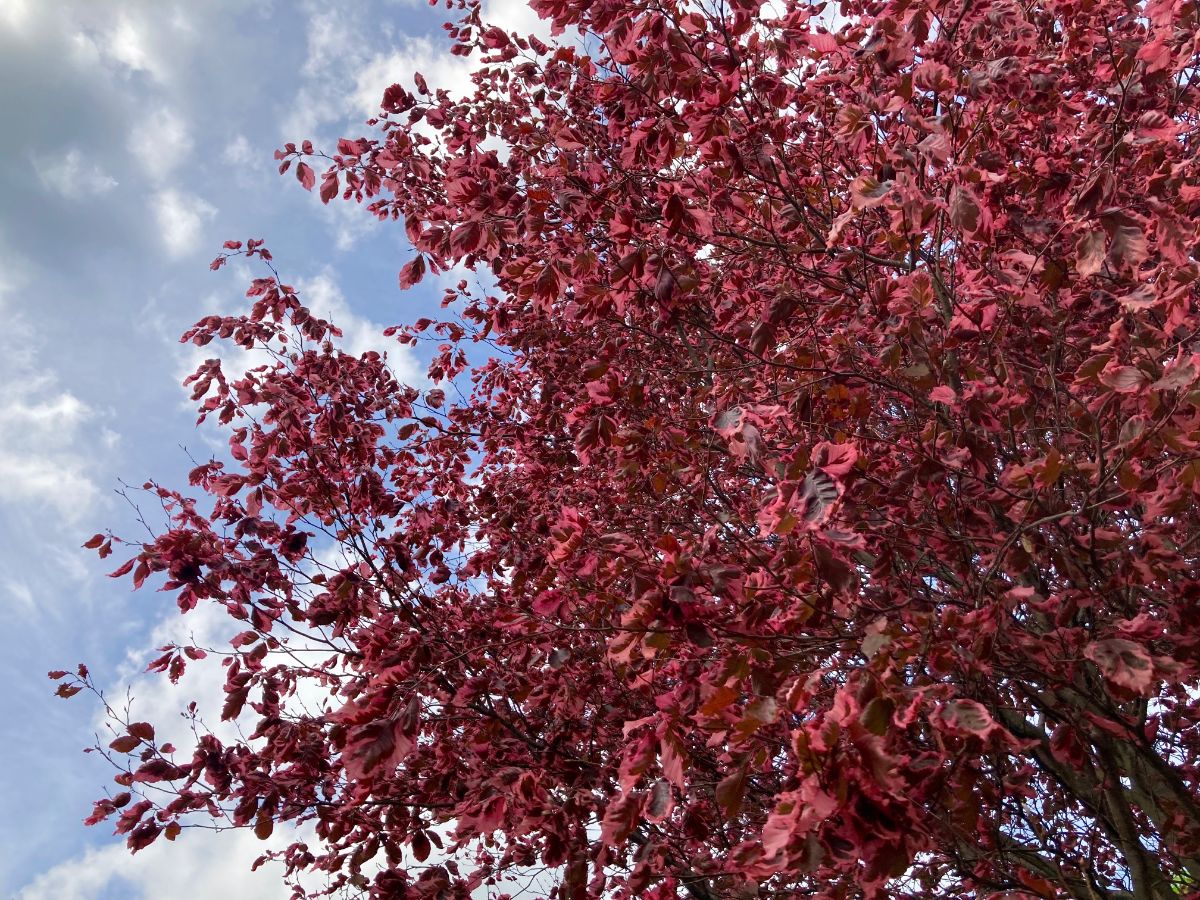
| Tree name: | Tricolor beech |
| Growing zone: | Zones 4 to 7 |
| Size: | 20 to 30’ high |
| Light requirements: | Part shade |
| Important features: | Colorful foliage; attracts wildlife |
From a distance, tricolor beech trees look almost pinkish in hue. But up close, you’ll see that those colorful leaves are actually a variegated medley of pinks, greens and white. Leaves are oval in shape, while the tree’s bark has a distinct silvery appearance.
A type of European beech, tricolor beeches will produce beechnuts, but they aren’t edible for humans. However, birds and other wildlife will happily munch on fallen nuts.
10. Hawthorn
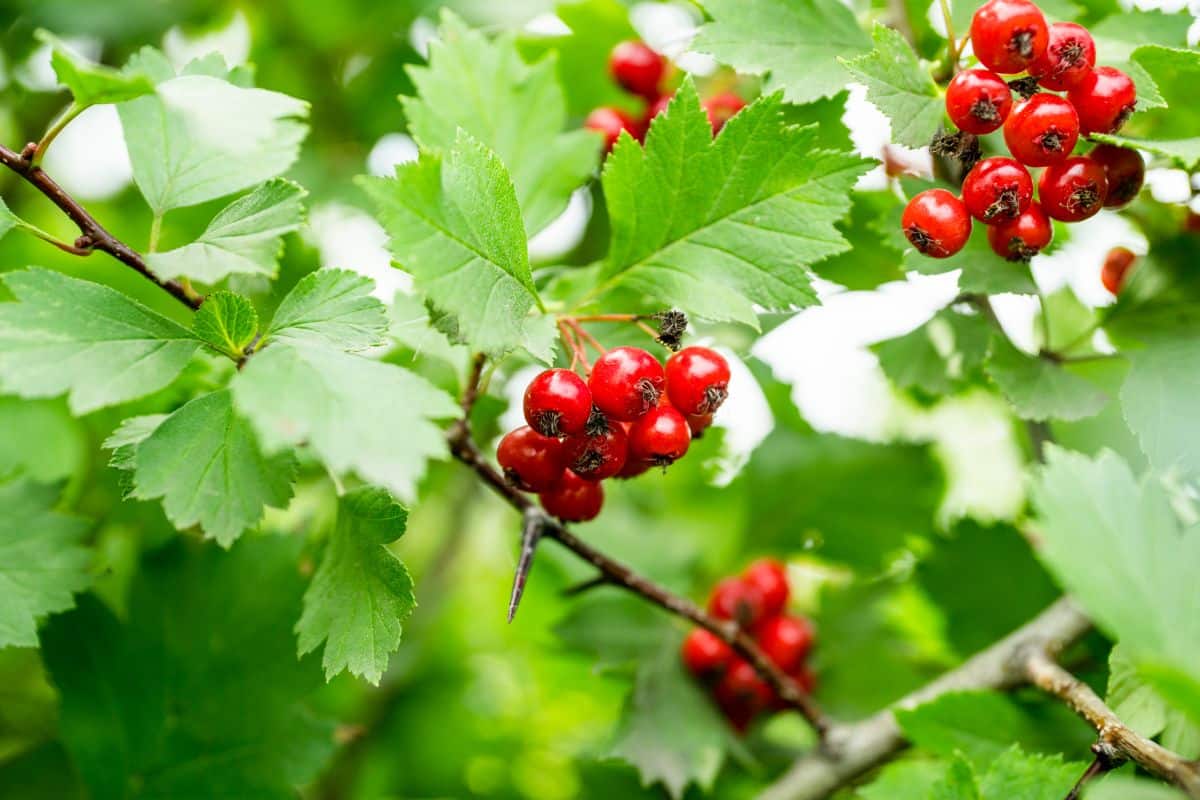
| Tree name: | Hawthorn |
| Growing zone: | Zones 5 to 9 |
| Size: | 15 to 30’ high |
| Light requirements: | Full sun |
| Important features: | Produces flowers; attracts birds |
A common sight in English hedgerows, there are different hawthorn varieties available, but a great choice for small gardens is ‘Prunifolia.’ This species of hawthorn stays quite small (16 ½’ high) and is known for its dark, glossy foliage and clusters of white flowers. Later in the season, red berries form (a favorite treat for visiting birds) and the foliage turns gorgeous colors too!
While hawthorn is perfect for attracting wildlife, it is also a hardy tree that can adapt to lots of different growing conditions. It can even grow in damp earth or areas exposed to harsher weather.
11. Chaste tree
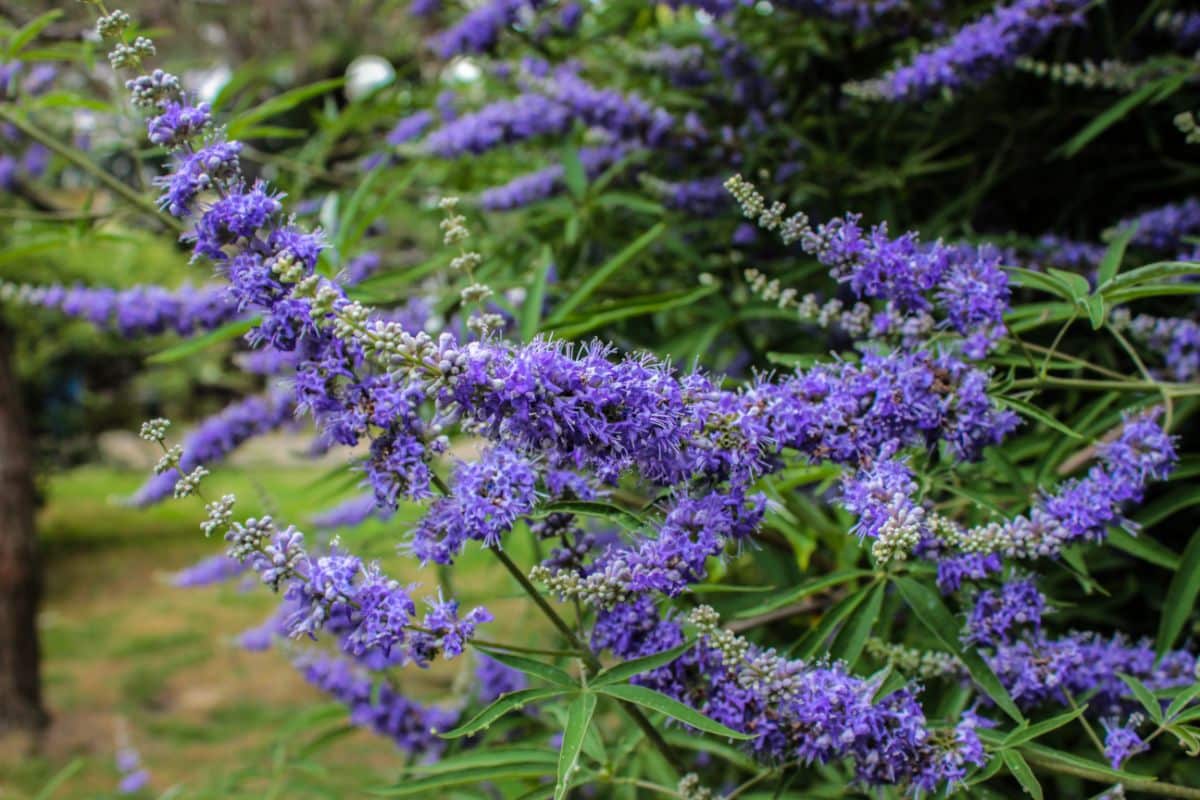
| Tree name: | Chaste tree |
| Growing zone: | Zones 6 to 9 |
| Size: | 3 to 20’ high (depending on the variety) |
| Light requirements: | Full sun to part shade |
| Important features: | Produces flowers; pollinator favorite |
Chaste tree isn’t very cold hardy so it may die back and grow more shrublike in cooler regions. However, if you live in a milder climate it is a fun and unusual choice for a specimen tree!
Beautiful, conically shaped purple flowers bloom in summer and are sure to attract hummingbirds, bees and other pollinators. If you love lots of color, this is the tree for you, because it’s hard to take your eyes away from all those purple flowers when they appear!
Chaste trees are lesser known in many gardening circles, but they come from the Mediterranean and are quite adaptable. Some gardeners also refer to them as vitex, Abraham’s balm and lilac chaste tree.
12. Amelanchier
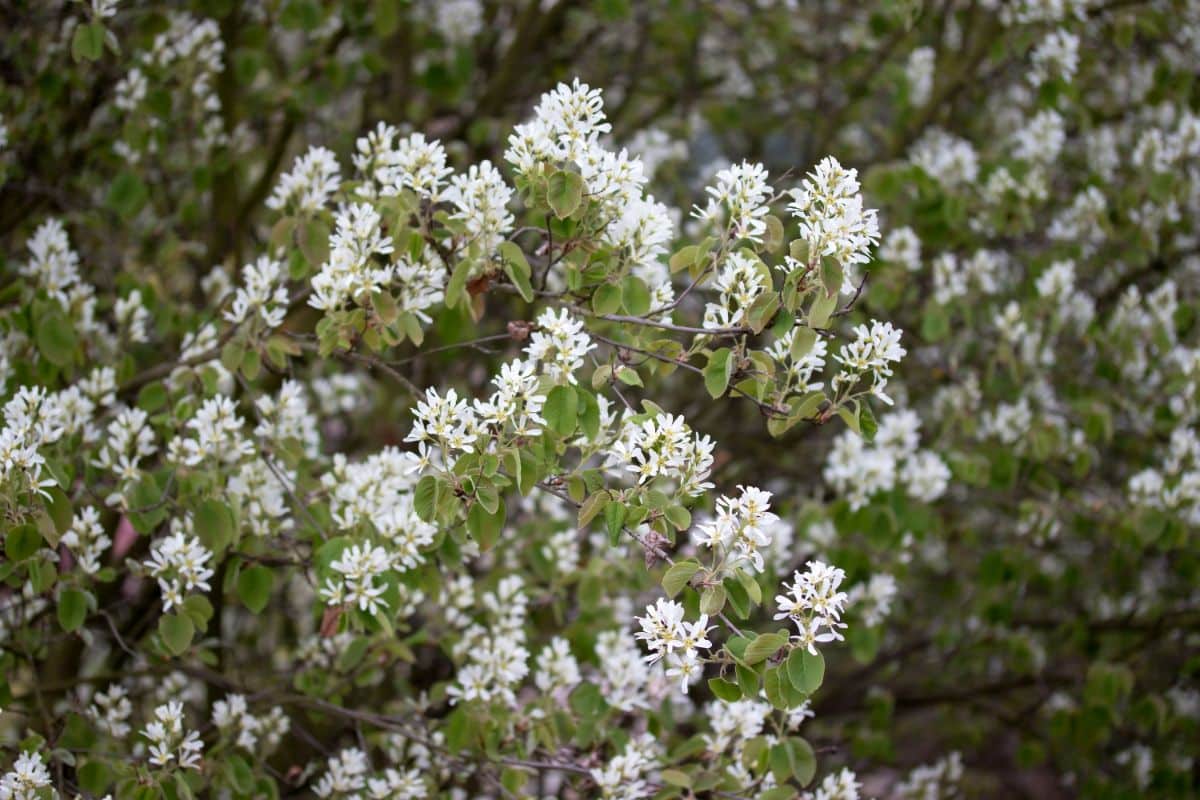
| Tree name: | Amelanchier |
| Growing zone: | Zones 4 to 9 |
| Size: | 15 to 25’ high (depending on the variety) |
| Light requirements: | Full sun to part shade |
| Important features: | Colorful foliage; edible fruit; produces flowers; pollinator favorite |
Also known as Juneberry and serviceberry, Amelanchier are deciduous trees prized for their clusters of fragrant, white, star-shaped flowers and copper-brown foliage that turns bright red and orange in autumn. Flowers are a hit with bees, but when they turn into reddish-purple berries, birds love them too. These berries are also edible for humans and make a tasty jam if you’re in to preserving.
Hardy trees, Amelanchier can adapt to a range of conditions, including moist or damp soils. While there are different varieties to choose from, ‘Ballerina’ or ‘Snow Flakes’ are two popular options that rarely grow over 16’ high.
13. Espalier apple trees
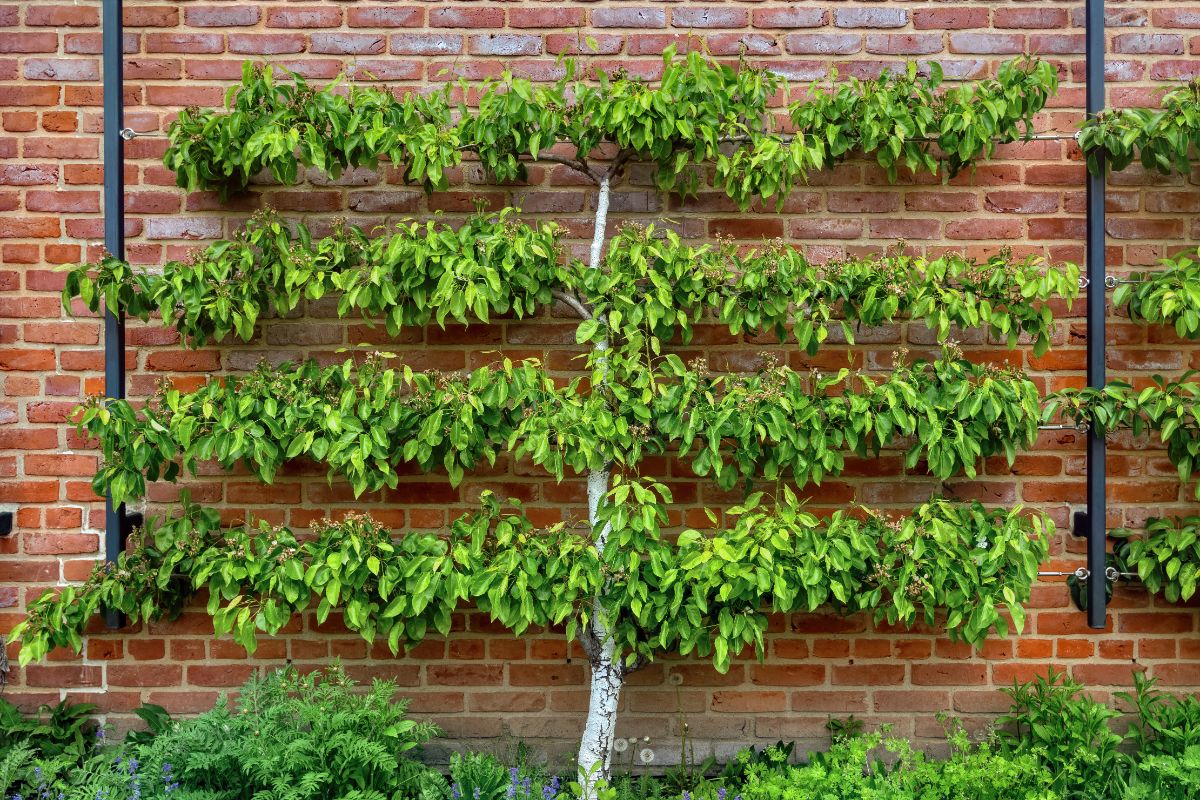
| Tree name: | Espalier apple trees |
| Growing zone: | Zones 4 to 9 |
| Size: | 6 to 8’ high |
| Light requirements: | Full sun |
| Important features: | Edible fruit; produces flowers; container garden-friendly |
For something really different (and a really smart way to use limited space), espalier apple trees are the way to go. Espalier trees are trees that have been pruned and trained very carefully so that they grow on a single plane. Rather than branching out, these trees are often trellised or placed flat against walls or fences where they take up minimal space.
While different trees, including a variety of fruit trees, can be grown with this technique, espalier really shines with apple trees. Not only does this technique create a really eye catching tree, but trees can also be grafted with multiple apple varieties growing on a single trunk. Talk about a space saver!
Because they are essentially just apple trees, espalier specimens can be treated much like standard apple trees, with similar growing requirements. But because they are so compact, they can also be grown in containers.
14. Weeping larch
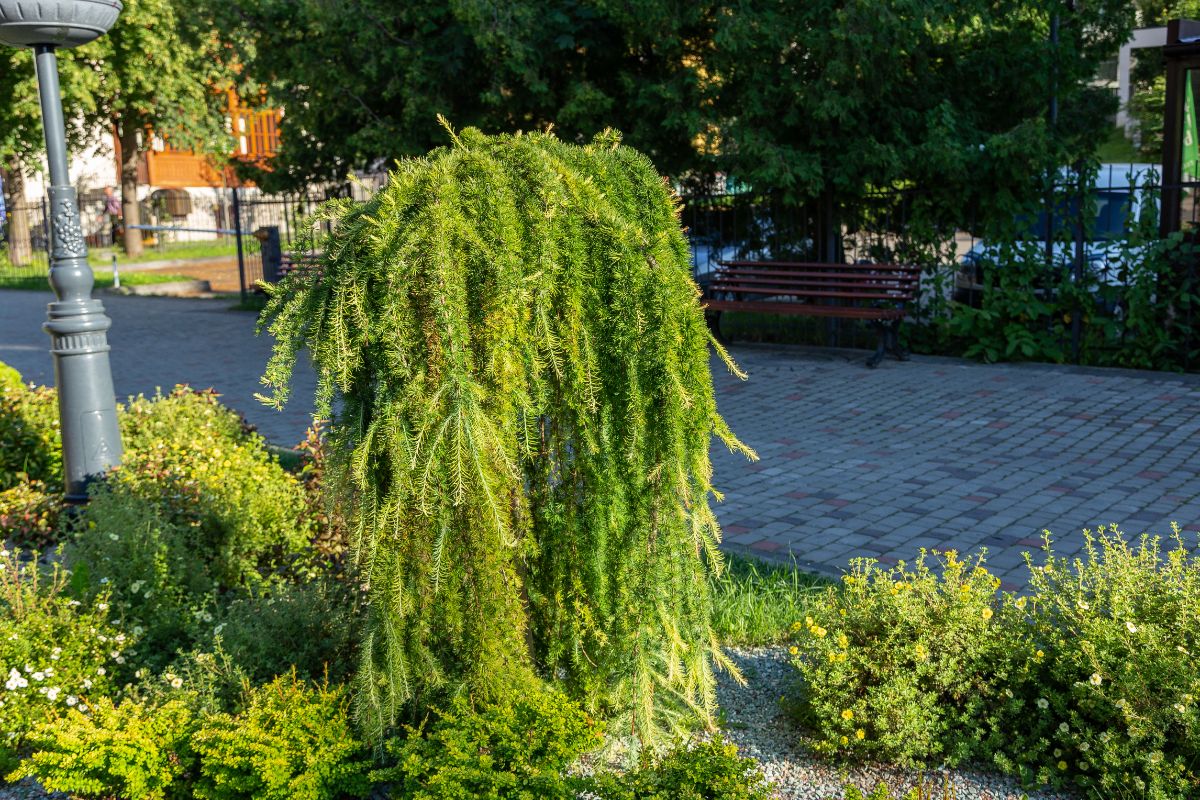
| Tree name: | Weeping larch |
| Growing zone: | Zones 2 to 6 |
| Size: | 13’ high |
| Light requirements: | Full sun to part shade |
| Important features: | Colorful foliage |
Highly structural trees, weeping larches are made for small spaces. In garden beds, they command attention with their draping branches that cascade beautifully. They are also intriguing enough to be planted on their own as whimsical specimen trees.
While they look like evergreens with tons of bright green needles, weeping larches are actually deciduous. In autumn their needles turn a vibrant yellow, before falling off and regrowing in springtime.
15. Redbud
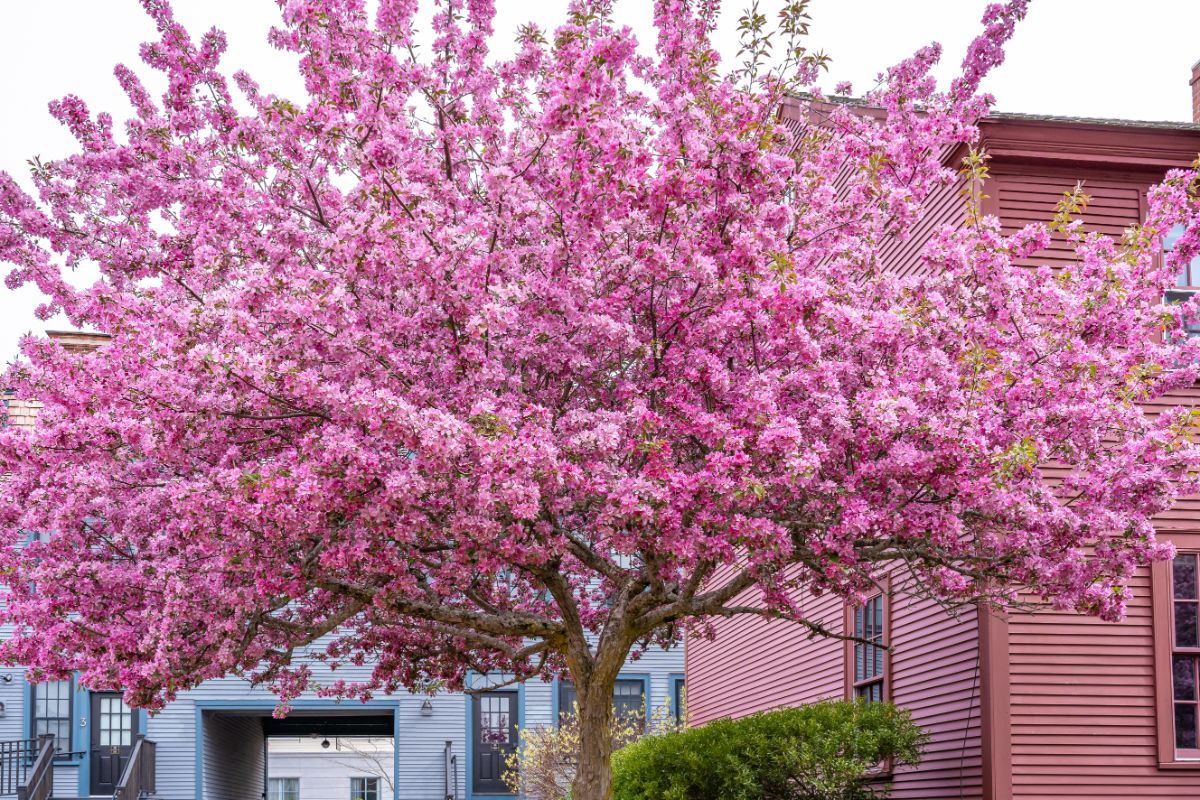
| Tree name: | Redbud |
| Growing zone: | Zones 4 to 9 |
| Size: | 12’ high (dwarf varieties); 20 to 30’ high (standard varieties) |
| Light requirements: | Full sun |
| Important features: | Produces flowers; colorful foliage |
Redbud is a colorful garden treat with small pink or purple flowers that appear in spring. These flowers are a nice contrast to the rich foliage, which appears after flowers fade. Heart-shaped leaves can be golden or reddish depending on what redbud variety you’re growing.
An easy to maintain tree, redbuds are staples in backyard gardens, where they can grow up 30’ high. However, dwarf varieties are available for smaller gardens and they’ll still deliver a vibrant pop of color every year.
16. Rowan
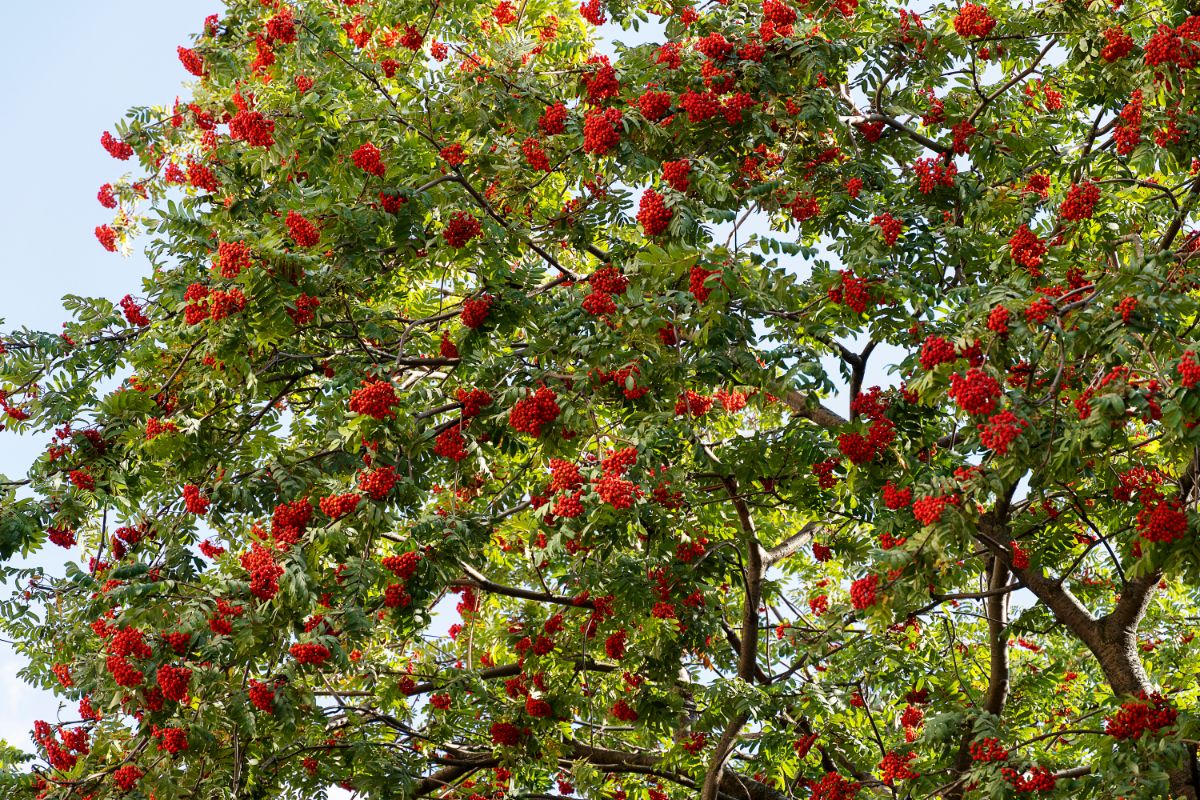
| Tree name: | Rowan |
| Growing zone: | Zones 3 to 5 |
| Size: | 15 to 30’ high (depending on the variety) |
| Light requirements: | Full sun to part shade |
| Important features: | Produces flowers; attracts birds; privacy |
Also known as mountain ash, rowan are beautiful trees that are perfect choices for creating a bit more privacy in your small yard. With feathery leaves and bunches of red berries that ripen in autumn, rowan is a good tree to try if you’re looking for something a bit different or you want to attract more birds to your yard.
While some species grow larger, dwarf rowan trees are available and they rarely grow above 13’ high. Some even produce frothy sprays of white flowers in summertime for even more color contrast.
17. Purple fountain weeping beech

| Tree name: | Purple fountain weeping beech |
| Growing zone: | Zones 4 to 7 |
| Size: | 25’ high |
| Light requirements: | Full sun |
| Important features: | Colorful foliage |
Weeping beeches grow tall, but they don’t spread out, making them ideal for narrow spaces. With glossy, rounded leaves in a rich purple, cascading from long delicate branches, these trees are certainly unique and produce an unforgettable silhouette in the garden.
Unlike other beech trees, weeping beeches grow rather slowly. Preferring full sun and occasional watering in extreme heat, these trees are low maintenance and hardy from zones 4 to 7.
18. Loquat
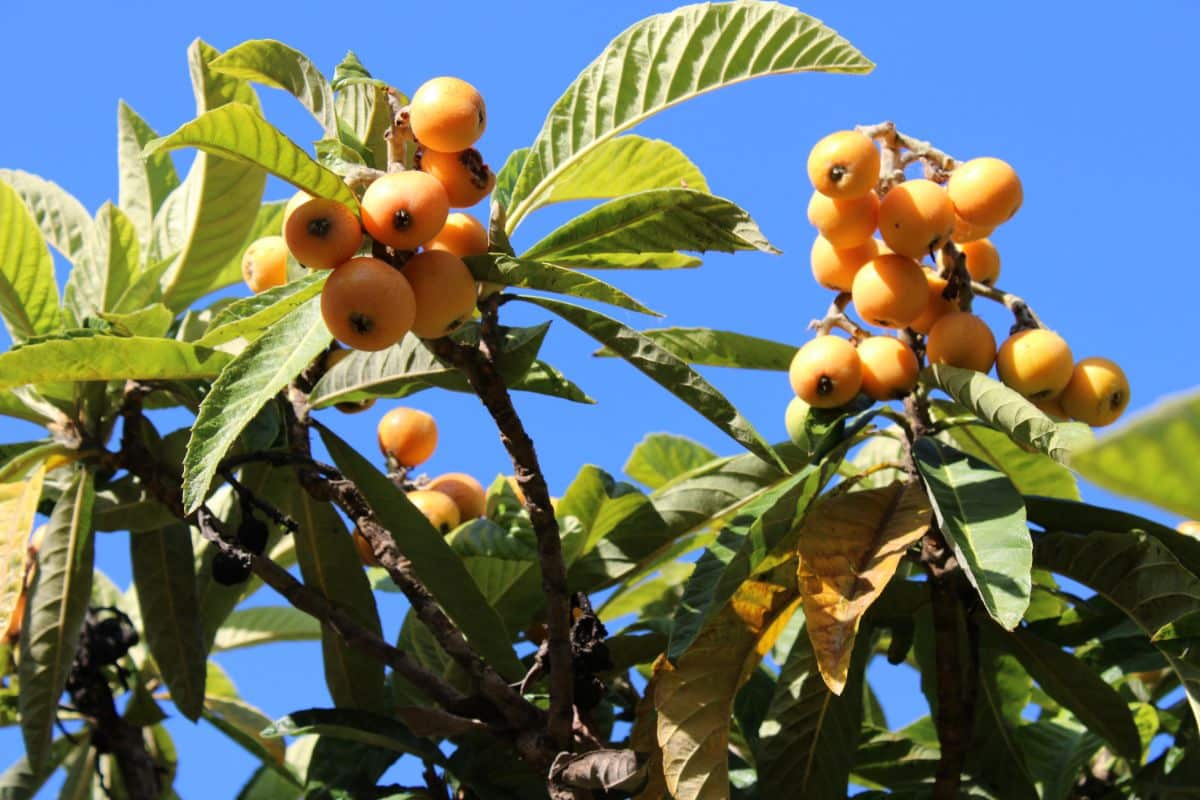
| Tree name: | Loquat |
| Growing zone: | Zones 8 to 10 |
| Size: | 6 to 35’ high (depending on the variety) |
| Light requirements: | Full sun |
| Important features: | Edible fruit; container garden-friendly |
Loquats are lesser known fruit trees, that produce bunches of sweet to slightly acidic, small yellow fruit. Perfect for jams, jellies, cobblers and pies, loquat fruit can be peeled and eaten fresh too.
Like many fruiting trees, loquats grow in warmer areas, so they may not be the best choice if you live in a cold region. However, they can be grown in containers too, allowing you to bring them inside in autumn if you’d like.
While loquats are mostly grown for their fruit, they produce whorls of deep green, glossy leaves that are quite dramatic and lend a bit of tropical flair to planted landscapes.
19. Dwarf Olive tree
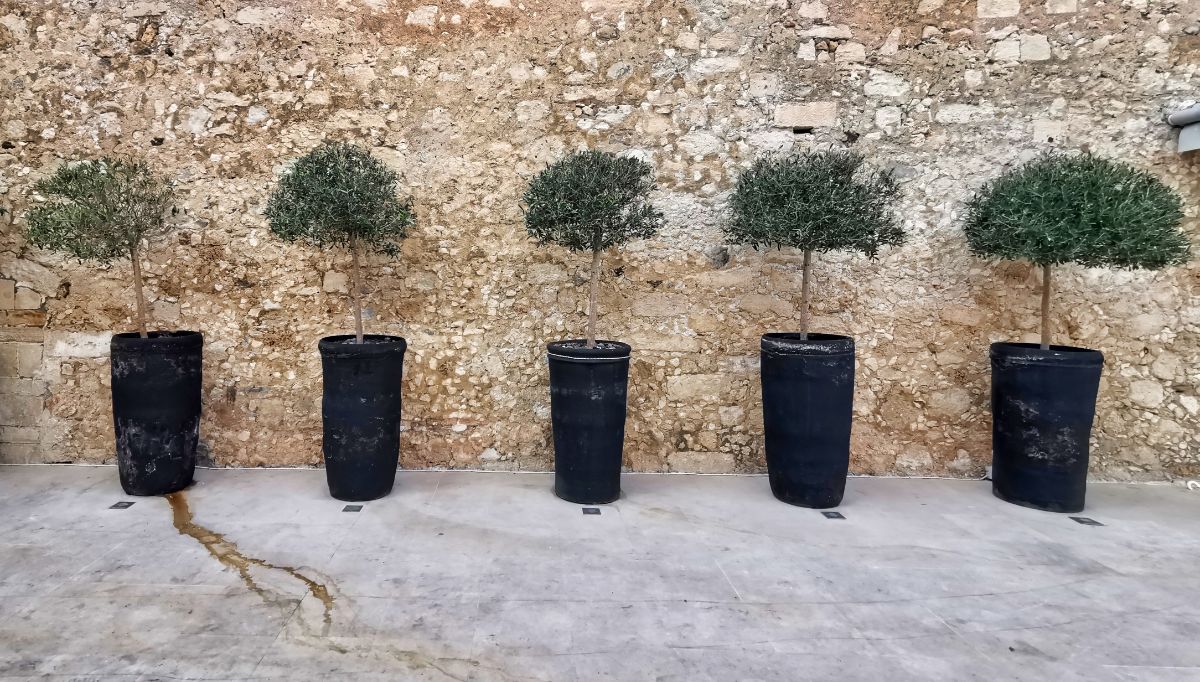
| Tree name: | Dwarf Olive tree |
| Growing zone: | Zones 10 and 11 |
| Size: | 8 to 10’ high |
| Light requirements: | Full sun |
| Important features: | Edible fruit; container garden-friendly |
For a little Mediterranean flavor, olive trees are hard to beat. These slow-growing trees grow well in containers and look gorgeous on sunny back patios where their silvery-green foliage can’t help but impress. But if you’re really lucky, they may treat you to your very own harvest of fresh olives in autumn, once the trees are well-established.
Preferring well-draining soil, olive trees should be fed monthly with a good balanced or low-nitrogen fertilizer during the growing season (spring to fall). Not cold hardy, olive trees only grow in warmer climates and should be protected with horticultural fleece if frost is on the forecast. Trees can be kept pruned for a tidy, traditional look or allowed to grow more wild – it’s up to you!
20. Dwarf Weeping Colorado spruce
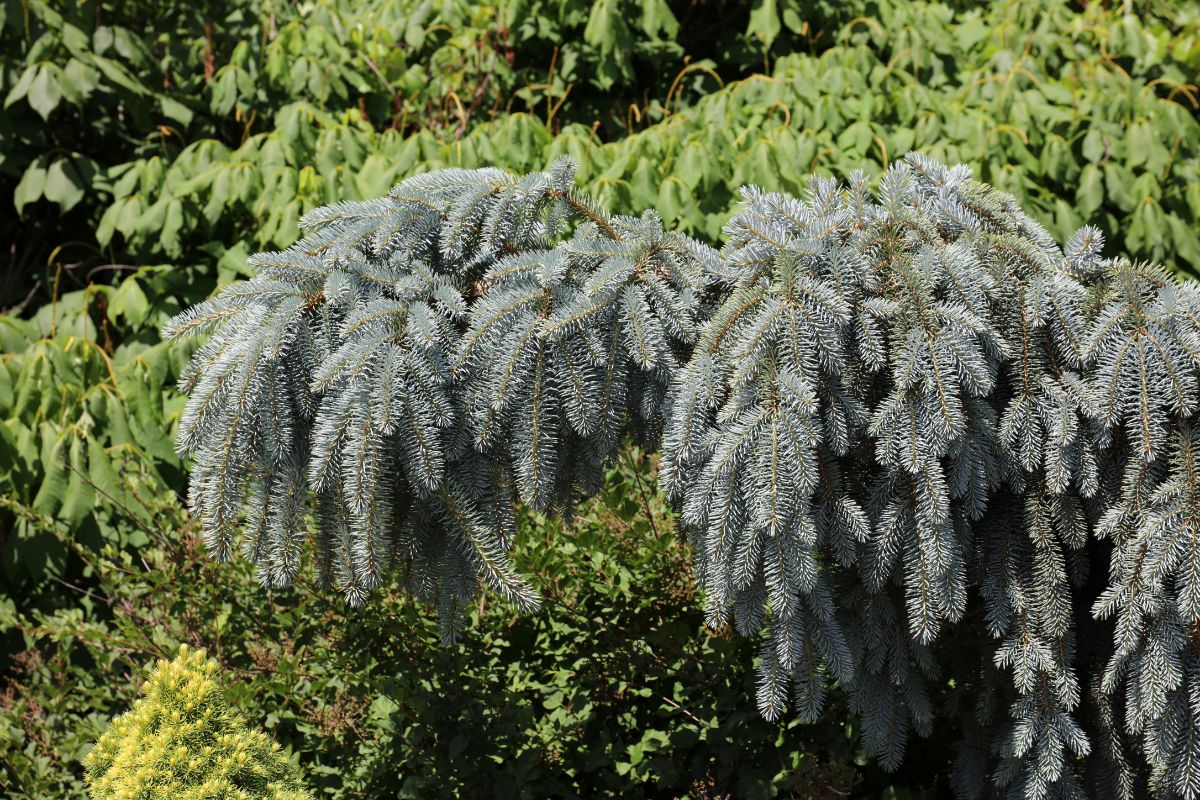
| Tree name: | Dwarf Weeping Colorado Spruce |
| Growing zone: | Zone 2 |
| Size: | 10’ high |
| Light requirements: | Full sun to part shade |
| Important features: | Pollinator shelter; year-round privacy |
A gorgeous specimen tree that looks attractive as a centerpiece in ornamental beds, weeping Colorado spruces are popular dwarf evergreen trees. With blue-green needles adorning gracefully drooping branches, weeping spruces add an intriguing, structural element to landscape designs.
Hardy down to -50°F, weeping spruces are fast growing plants and are deer-resistant too. No matter your backyard layout, these trees are quite good at adapting to a range of conditions, including full sun to part shade. They also provide excellent shelter for birds and other pollinators!
Benefits of adding trees to your small garden
Trees provide us with so much. They give us shade and shelter from the hot sun, purify air and even sometimes offer us fruit, gorgeous flowers and stunningly colored foliage too!
There are so many reasons to add trees to your garden space; however, if you have a small backyard, you may think planting trees is out of the question. Happily, there are lots of ornamental trees that are small-space friendly, and some can even be grown in containers on backyard patios.
Some of the key reasons to add trees to your garden include:
- Focal point. While smaller plants and flowers have their place, for that real “wow” factor plant ornamental trees. Because they’re larger, trees lend structure to landscape designs and can be used to section off garden areas or deliberately draw the eye to certain spots.
- Year round interest. From spring flowers to colorful autumn leaves, ornamental trees are always changing. That means, no matter the season, there will always be something interesting going on in your garden!
- Planting an ornamental tree is a great way to create a sheltered area of your garden for reading nooks or relaxing hammocks. You can also use small trees to create mini shade gardens and beds for more delicate understory plants and flowers.
- Many ornamental trees boast nectar and pollen-rich flowers that pollinators love. And when those flowers mature, they turn into berries for hungry birds. What’s more, the sheltering leaves and sturdy branches of trees can provide much-needed shelter for nesting birds and sleepy pollinators.
- Fruit, flowers and color. Despite their small size, some ornamental trees can produce tons of edible fruit and gorgeous flowers for indoor bouquets. Other trees have vibrant foliage in pinks, purples, copper and more for lots of visual interest in your garden.
- Planting trees, especially small evergreen trees, is a wonderful way to create a natural privacy screen in your yard. Positioning trees just so can also help cover up unsightly utility boxes and other issues you’d rather not look at.
- Noise reduction. A well-placed tree is an easy way to filter out unwanted noise from nearby traffic or noisy neighbors. Although trees alone can’t create an entirely tranquil, noise-free yard, their broad leaves and woody trunks will help buffer some of the loudest noises.
When is the best time to plant trees?
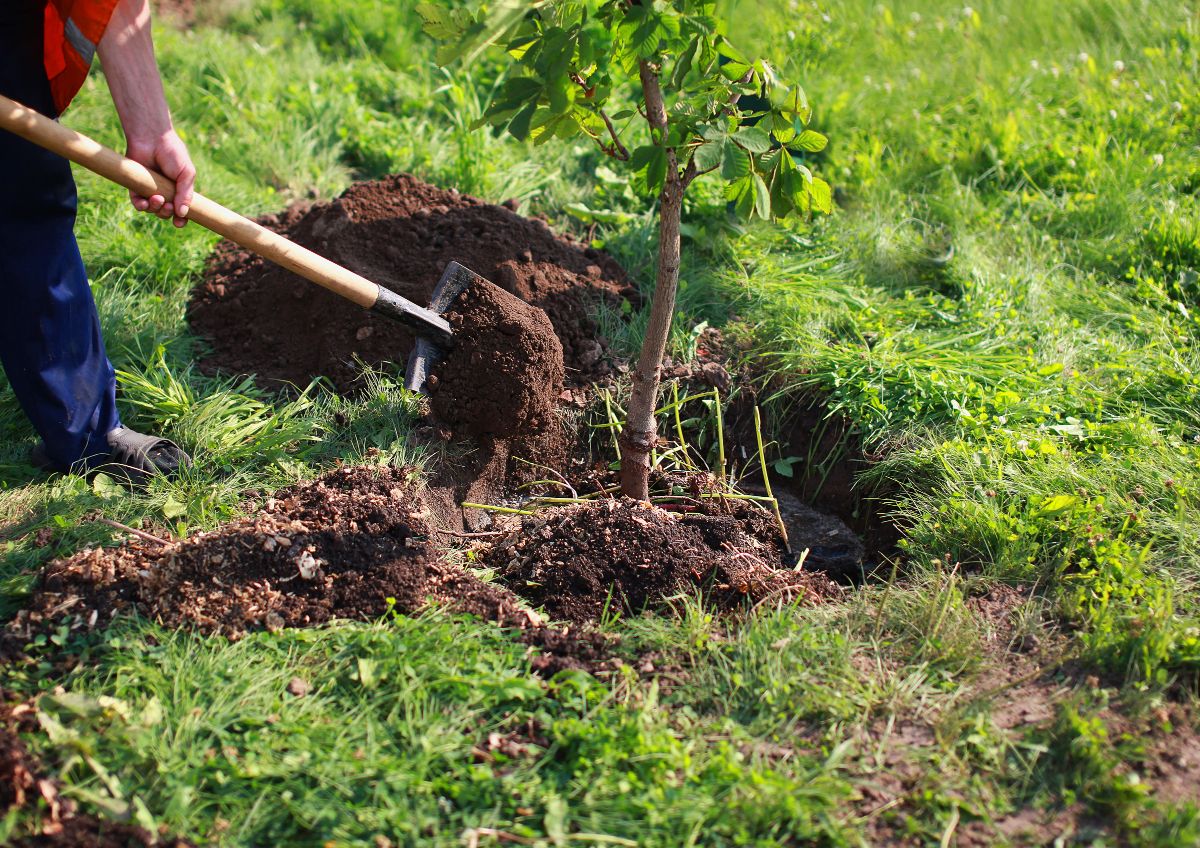
Generally speaking, most trees do best when planted either in spring or fall. Because temperatures are cooler and rain is more plentiful during these seasons, newly planted trees are better able to adapt to transplanting.
Whether you decide to plant in spring or fall really depends on you and your local weather. While spring planting can work well, if you know you have a short springtime in your area, you may want to opt for fall planting instead so your trees have more time to settle in.
Conversely, if winters come early to your area, you may instead choose to plant trees in spring or early in fall so their roots have enough time to settle in before winter really begins.
Many gardeners recommend autumn planting for deciduous trees specifically, with the months of October and November being ideal planting times. This is because many deciduous trees concentrate their energy towards root growth during the cooler period of the year and soil moisture levels are usually high at this time. Additionally, trees are often on sale for discounted prices towards the end of the year so you may be able to score a deal with your new plantings.
Spring planted trees should do just fine too, and may settle in quicker as they’ll have a longer growing period before winter. Spring planted trees will need a bit more tending and watering though, especially when summer heat rises, to prevent issues with transplant shock.
In most areas, winter is usually not a great time for tree planting as soil is frozen and water access is limited. Summer planting is also generally discouraged as hot temperatures and fast water evaporation rates can put unnecessary stresses on newly planted trees.
How to plant your ornamental tree
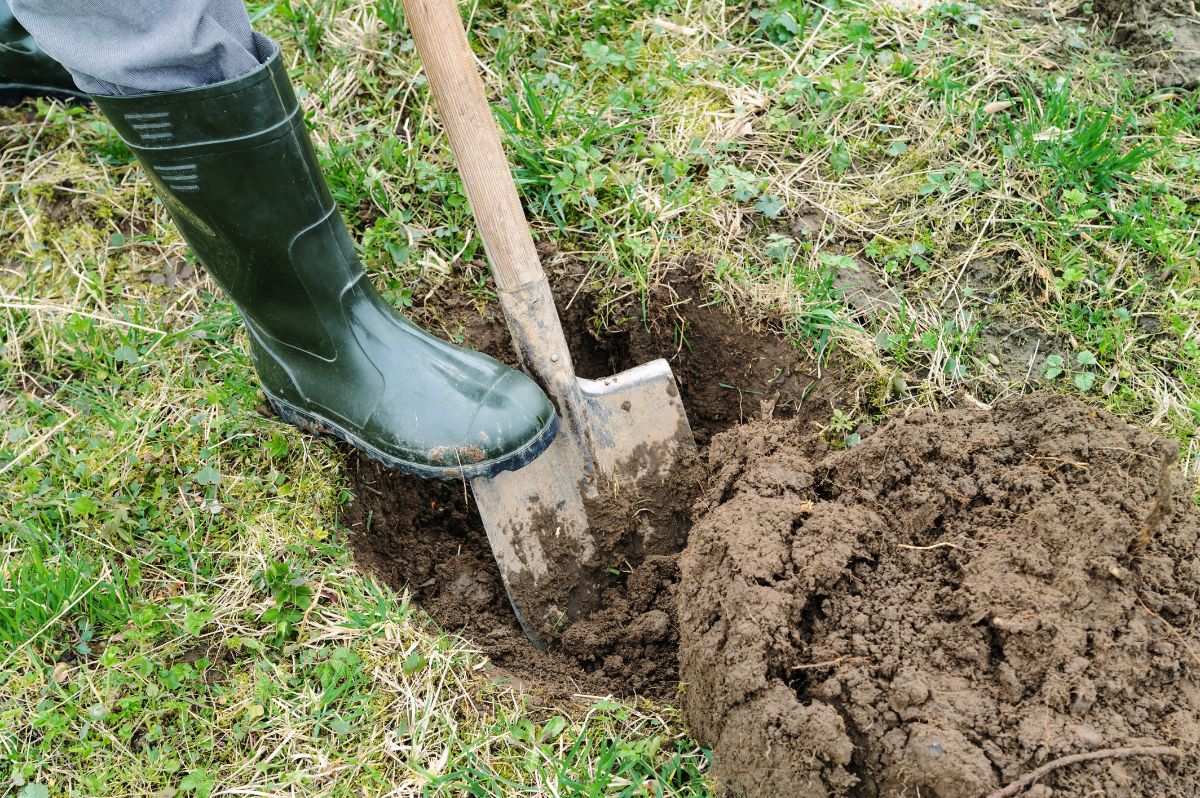
When you purchase your trees, they’ll usually come in one of three ways. They’ll either be sold “B&B” (standing for "balled and burlapped," with burlap around the roots), in containers or bare root.
B&B trees have large root balls, which are sometimes enclosed within a wire basket inside the burlap covering. These tree varieties are best planted in spring and early fall. Trees planted in plastic containers should also be planted in spring or fall, while bare root trees are in their dormancy and should be planted when its even cooler out (early spring and late fall).
For safety and tree health, when selecting your trees, be sure to always carry them by their root balls, rather than their trunks, and support containers well with both hands.
Prep work
Once you get your new trees home, you’ll want to prepare your planting hole, but don’t overdo it. Many gardeners think they have to do a lot of prep work to ready planting sites prior to planting their trees, but if your soil is already rich and well-draining, you won’t need to add much (if any) amendments.
For starters, try testing your soil with a home test kit and amending it if needed. If your soil is thick in clay and poorly draining, sand and compost can help improve drainage. Dry soil, on the other hand, can be enhanced with just a layer of compost which will help retain moisture.
If your soil has a pH imbalance, it can be easily fixed with natural amendments like sulfur or lime.
To help your tree transition to its new home more easily, water your tree’s roots thoroughly before prepping your planting location so the roots have some time to absorb the moisture they need.
Digging your planting hole
After testing your soil, you’re ready to dig your planting hole.
Many gardeners make the mistake of digging too large of a hole. In reality, your tree hole should be deep enough and wide enough for roots to spread comfortably but not so deep that it can cause issues with soil stability.
An ideal tree hole should be just as deep as the root ball and about three times as wide. This will ensure your tree’s roots have enough area to spread, but won’t overwhelm roots with too much heavy soil. Soil underneath your tree’s roots should be left undisturbed as you’ll want to plant your tree on solid ground that won’t settle later.
If you’re using any soil amendments, mix them in thoroughly to any dirt you removed from the planting hole so they’re evenly distributed. Be sure to break up any tough clumps of soil and pick out large rocks too.
For bare root trees, it can sometimes help to build an “inverted cone” of soil at the base of your planting hole to support the center of the tree and help spread out tree roots more easily.
Planting your tree
Once your soil is prepped and your hole is dug, you’re ready to plant!
Carefully remove your tree from its container, being careful not to damage delicate roots in the process. Depending on how your tree was packaged, you may need to snip away twine, burlap and wire root cages or carefully wiggle your tree free from its plastic container. If your tree was sold with burlap and twine around the roots, its important that you cut these away as sometimes they are treated for rot resistance and won’t break down if planted with your tree.
After you’ve freed your tree’s roots, gently loosen them up a bit. If you don’t loosen roots up they may circle around the planting hole, rather than growing outwards, and this can weaken or kill your tree. For container-grown trees, you may also want to snip away any rotted or broken roots to stimulate growth, but don’t remove too many.
Now, lower your tree into your planting hole and straighten it out. The root flare (the area where the trunk meets the roots) should sit approximately at ground level or slightly above it. You don’t want to position your tree too low in the hole.
Spread out the roots some to encourage growth and then backfill your planting hole with your amended soil, packing it around tree roots to remove any air pockets. When your hole is filled, firmly tamp down the soil.
If you end up with extra soil after planting your tree, create a low, circular berm of soil around the outer margins of your tree hole. This berm can help catch and direct water back to tree roots, which is particularly important for newly planted trees as they settle into their new home. The berm can be removed and leveled out after a few months.
After care
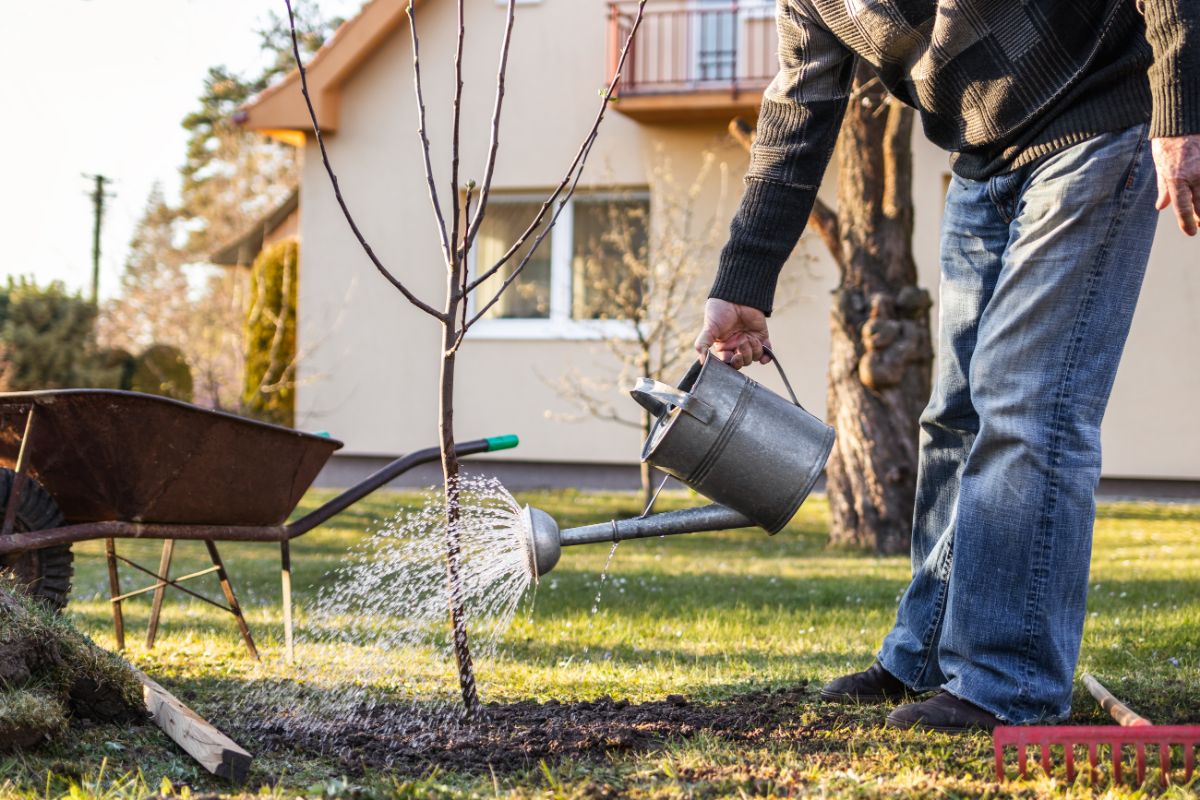
When your tree is planted, add a 2 to 3” layer of natural mulch around the base of the tree to help retain moisture and prevent weeds. Any natural mulch will do; however, wood chips and bark mulch are popular choices for this. When mulching, never place mulch directly up against tree trunks to prevent rot and other issues.
While staking is not normally necessary, if you planted your tree in a very windy spot or it is naturally bending a little, staking can help. That said, trees grow stronger trunks and root systems if they are allowed to sway in the wind, so only use stakes if you think you need them.
Any stakes you use should be flexible enough to move with your tree and should allow your tree to move at least 1” in any direction. Place stakes down as low as possible and try placing a stake on either side of your tree for best results. If you need to use any wire with your setup, be sure rough wire is enclosed within rubber hoses to prevent trunk damage.
After one year or less, remove stakes to prevent girdling and tree death. Any wrapping on your tree’s trunk should also be removed for the same reasons. If you have voles, deer or other garden pests that enjoy munching on tree bark, consider adding loose tree guards if you think you need them.
And of course, the most important thing to do after planting your tree is to water it well. Newly planted trees should be provided with consistently moist, but not soggy, soil. For the first two weeks after planting, new trees should usually be watered daily, while watering can be reduced after the tree begins to become established.
Conclusion
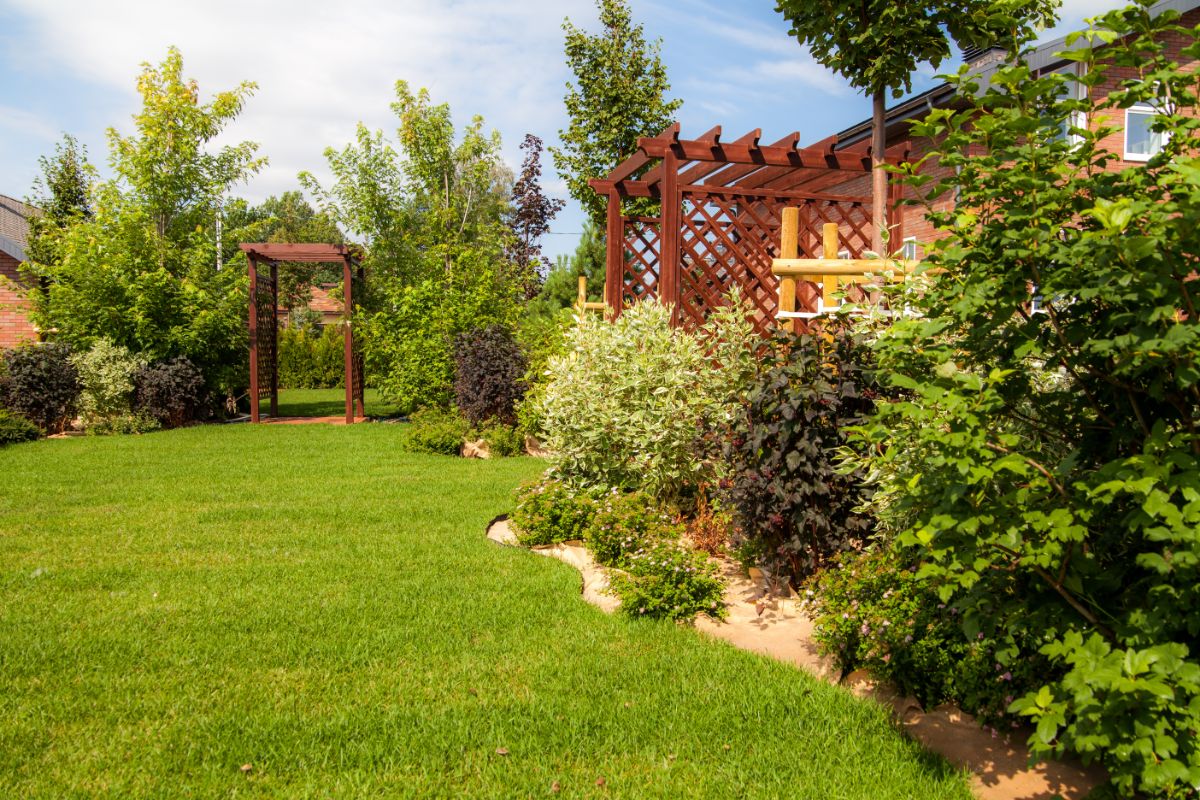
Just because you have a small garden doesn’t mean you can’t have an ornamental tree or two for lots of visual impact. Although most home gardeners think trees need tons of growing space, dwarf trees and petite specimen trees can grow in surprisingly small areas – even in containers!
But while specimen trees are lovely for the eye, some ornamental trees can provide so much more than that. From fruiting trees to colorful seasonal flowers, many trees offer tangible benefits that we can enjoy and even devour. Better still, certain trees are irresistible for pollinators and birds and can be an essential part of habitat building and pollinator gardening.
If this article has intrigued you and you’re ready to plant your first specimen tree, check out your local plant nursery where you’re sure to find many of these popular trees. And, for more difficult to find tree types (like loquats), the internet is always a great source and you can have your very own ornamental tree shipped right to your door!
References:
- Cumberpatch, Fiona. “Best Trees for Small Gardens.” Gardening Etc. 13 August 2022. 16 August 2021.
- “How to Plant Trees and Shrubs.” Cornell University. 13 August 2022. February 2015.
- Raver, Jill. “Fig Trees.” Planting Tree. 13 August 2022. 8 February 2022.
- Sansone, Arricca Erin. “10 Best Trees for Small Gardens.” 13 August 2022. 26 May 2022.
- Walliser, Jessica. “Dwarf Evergreen Trees.” 13 August 2022. 2019 Savvy Gardening.

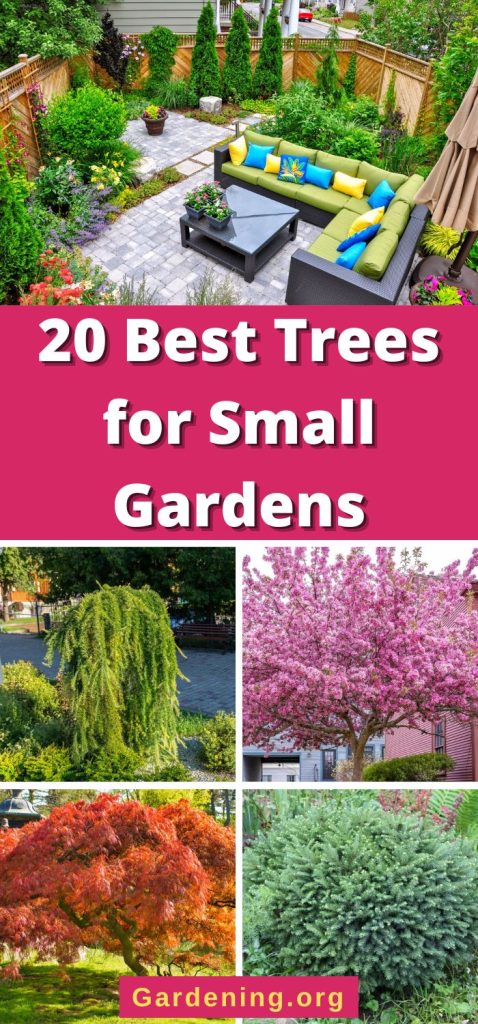
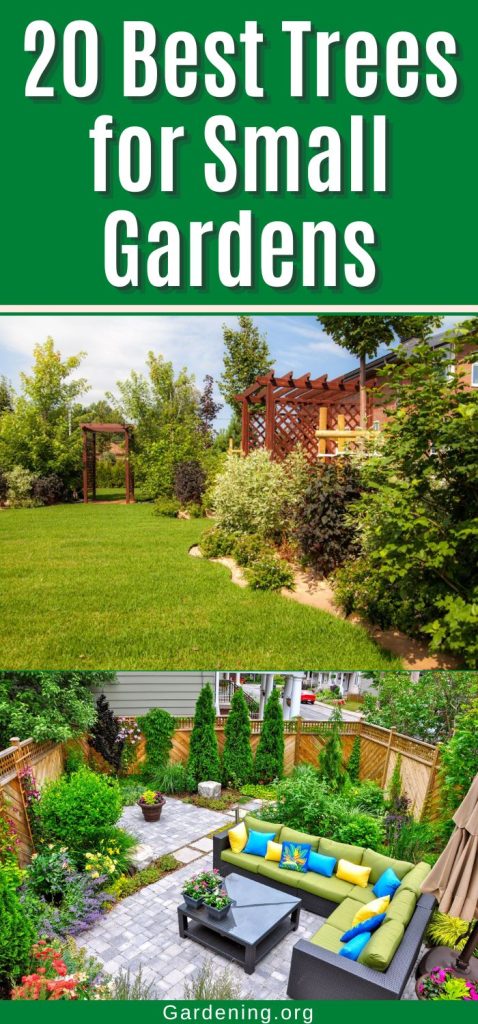
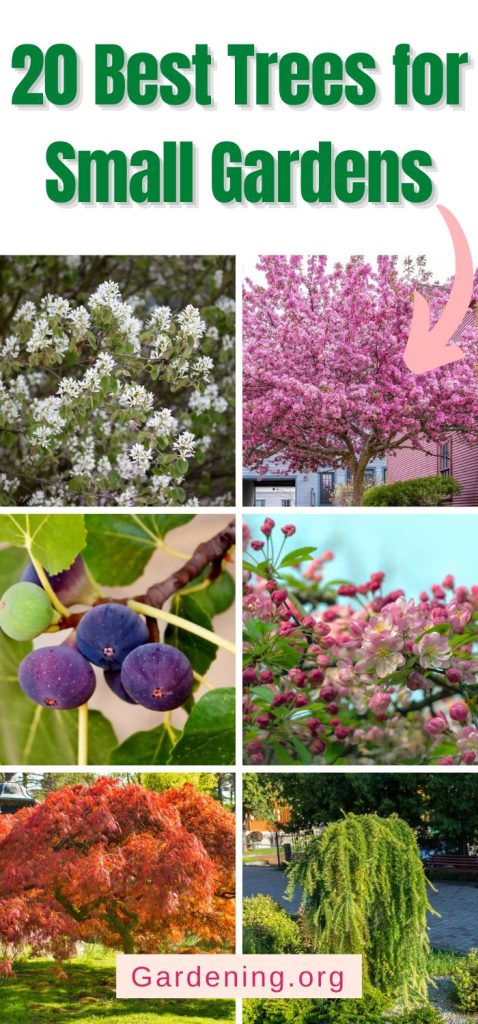
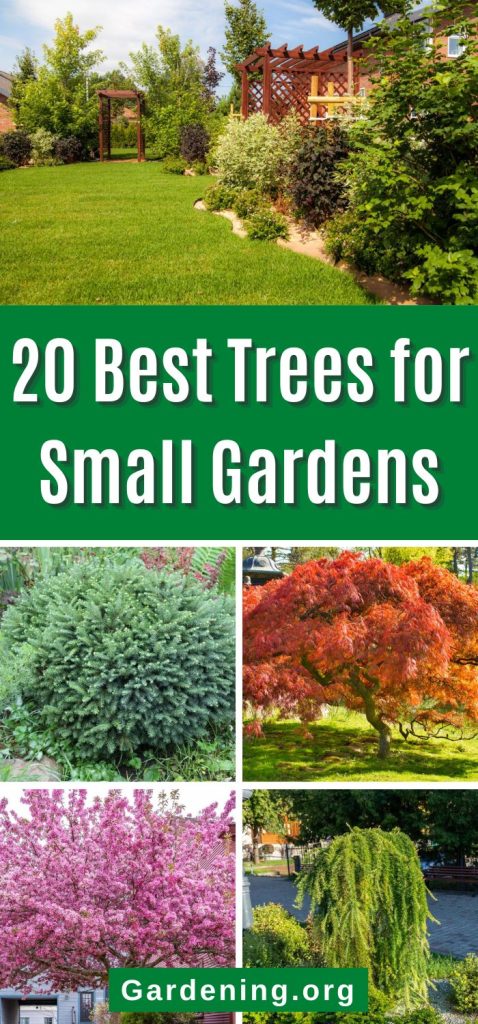
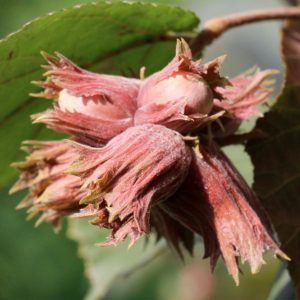
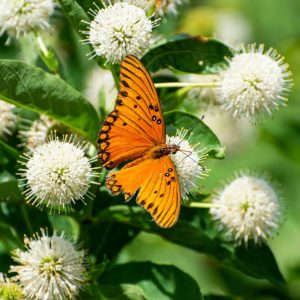
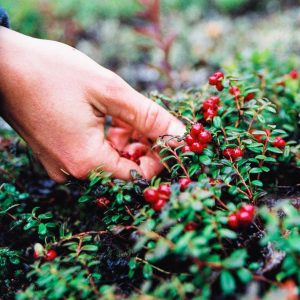
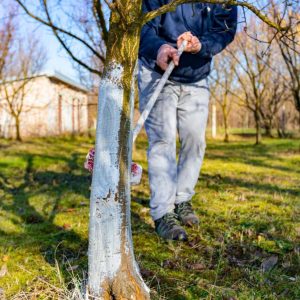
Leave a Reply